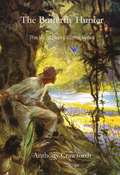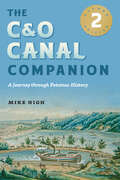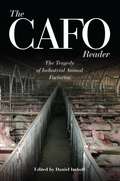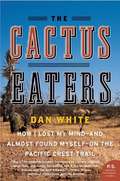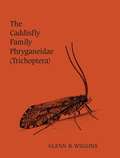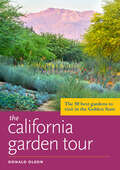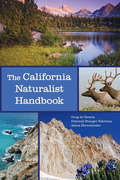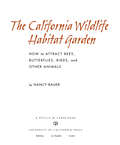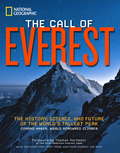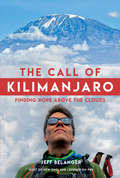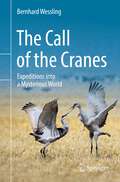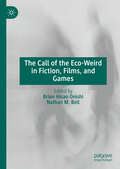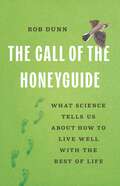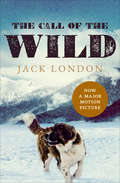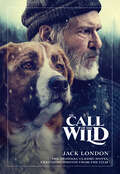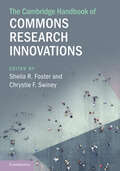- Table View
- List View
The Butterfly Hunter: The Life Of Henry Walter Bates
by Anthony CrawforthThis is the epic, true and long overdue story of the young explorer who put the first ever case for the creation of a new species, providing what Charles Darwin called the "beautiful proof" for Natural Selection.The major discovery of Batesian Mimicry was developed from Bates's fascinating 11-year journey and study of butterflies in the Amazon rainforest. He noted how certain animals adopt the look of others to deceive predators and gain an advantage to survive. Little known to the public, Bates made other crucial contributions to biology: he collected over 14,000 specimens, of which over 8,000 were at the time new to science. He went on to become the administrator for the Royal Geographical Society and transformed it into an institution which combined exploration with academic research and was responsible for placing geography on the school curriculum. This important book reassesses Bates's life and finally places both the man and his work in their rightful place alongside the other greats.
The C&O Canal Companion: A Journey through Potomac History
by Mike HighAn indispensable guide to a regional treasure—now thoroughly updated and expanded.A comprehensive guide to one of America's unique national parks, The C&O Canal Companion takes readers on a mile-by-mile, lock-by-lock tour of the 184-mile Potomac River waterway and towpath that stretches from Washington, D.C., to Cumberland, Maryland, and the Allegheny Mountains. Making extensive use of records at the National Archives and the C&O Canal Park Headquarters, Mike High demonstrates how events and places along the canal relate to the history of the nation, from Civil War battles and river crossings to the frontier forts guarding the route to the West. Using attractive photographs and drawings, he introduces park visitors to the hidden history along the canal and provides practical advice on cycling, paddling, and hiking—all the information needed to fully enjoy the park's varied delights. Thoroughly overhauled and expanded, the second edition of this popular, fact-packed book features updated maps and photographs, as well as the latest information on lodgings and other facilities for hikers, bikers, and campers on weekend excursions or extended outdoor vacations. It also delves deeper into the history of the upland region, relaying new narratives about Native American settlements, the European explorers and traders who were among the first settlers, and the lives of slaves and free blacks who lived along or escaped slavery via the canal.Visitors to the C&O Canal who are interested in exploring natural wonders while tracing the routes of pioneers and engineers—not to mention the path of George Washington, who explored the Potomac route to the West as a young man and later laid out the first canals to make the river navigable—will find this guide indispensable.
The CAFO Reader
by Daniel ImhoffThe CAFO Reader is possibly the most powerful indictment of factory farming ever compiled, with essays from 30 of the world's leading experts. It also offers a vision for a food system that leaves behind the horrific 20th century model of Concentrated Animal Feeding Operations.The CAFO Reader brings the tragic world of industrial food production into sharp focus with essays on every facet of factory farming: health, environment, animal welfare, labor, politics, economics, and so on. This affordable reader is a companion book to the larger photo-essay volume, CAFO: The Tragedy of Industrial Animal Factories. It is sure to become a relied-upon resource for activists, food policy makers, academics, the media and the general public for many years. This project is a follow-up to the highly successful project Fatal Harvest, published in 2002. It is being supported by an extensive outreach campaign with events around the country.
The CAFO Reader
by Daniel ImhoffThe CAFO Reader is possibly the most powerful indictment of factory farming ever compiled, with essays from 30 of the world's leading experts. It also offers a vision for a food system that leaves behind the horrific 20th century model of Concentrated Animal Feeding Operations.The CAFO Reader brings the tragic world of industrial food production into sharp focus with essays on every facet of factory farming: health, environment, animal welfare, labor, politics, economics, and so on. This affordable reader is a companion book to the larger photo-essay volume, CAFO: The Tragedy of Industrial Animal Factories. It is sure to become a relied-upon resource for activists, food policy makers, academics, the media and the general public for many years. This project is a follow-up to the highly successful project Fatal Harvest, published in 2002. It is being supported by an extensive outreach campaign with events around the country.
The Cabaret of Plants: Forty Thousand Years of Plant Life and the Human Imagination
by Richard Mabey"Highly entertaining…Without being sentimental about it, Mr. Mabey gets us to look at life from the plants' point of view. His science is sound, he's witty, and his language is engaging." —Constance Casey, New York Times The Cabaret of Plants is a masterful, globe-trotting exploration of the relationship between humans and the kingdom of plants by the renowned naturalist Richard Mabey. A rich, sweeping, and wonderfully readable work of botanical history, The Cabaret of Plants explores dozens of plant species that for millennia have challenged our imaginations, awoken our wonder, and upturned our ideas about history, science, beauty, and belief. Going back to the beginnings of human history, Mabey shows how flowers, trees, and plants have been central to human experience not just as sources of food and medicine but as objects of worship, actors in creation myths, and symbols of war and peace, life and death. Writing in a celebrated style that the Economist calls “delightful and casually learned,” Mabey takes readers from the Himalayas to Madagascar to the Amazon to our own backyards. He ranges through the work of writers, artists, and scientists such as da Vinci, Keats, Darwin, and van Gogh and across nearly 40,000 years of human history: Ice Age images of plant life in ancient cave art and the earliest representations of the Garden of Eden; Newton’s apple and gravity, Priestley’s sprig of mint and photosynthesis, and Wordsworth’s daffodils; the history of cultivated plants such as maize, ginseng, and cotton; and the ways the sturdy oak became the symbol of British nationhood and the giant sequoia came to epitomize the spirit of America. Complemented by dozens of full-color illustrations, The Cabaret of Plants is the magnum opus of a great naturalist and an extraordinary exploration of the deeply interwined history of humans and the natural world.
The Cabin: A Search for Personal Sanctuary
by Hap WilsonOne hundred years ago, a young doctor from Cleveland by the name of Robert Newcomb, travelled north to a place called Temagami. It was as far north as one could travel by any modern means. Beautiful beyond any simple expletive, the Temagami wilderness was a land rich in timber, clear-water lakes, fast flowing rivers, mystery and adventure. Newcomb befriended the local Aboriginals — the Deep Water People — and quickly discovered the best way to explore was by canoe. Bewitched by the spirit of an interior river named after the elusive brook trout, Majamagosibi, Newcomb had a remote cabin built overlooking one of her precipitous cataracts. The cabin remained unused for decades, save for a few passing canoeists; it changed ownership twice and slowly began to show its age. The author discovered the cabin while on a canoe trip in 1970. Like Newcomb, Hap Wilson was lured to Temagami in pursuit of adventure and personal sanctuary. That search for sanctuary took the author incredible distances by canoe and snowshoe, through near death experiences and Herculean challenges. Secretly building cabins, homesteading and working as a park ranger, Wilson finally became owner of The Cabin in 2000. Artist, author and adventurer, Hap Wilson is perhaps best known for his ecotourism/travel guidebooks. He has led over 300 wilderness expeditions in Canada, and served as actor Pierce Brosnan’s personal outdoor trainer for the feature film Grey Owl. "This is a complex and fascinating story, beautifully told. At first, it draws us in because the author appears to be living the life we all dream of-a simpler life, close to nature, free from the stress and strain of our consumer culture. But the reality, with its myriad challenges, is what holds our attention and gives the book its substance." — Judith Ruan, Muskoka Magazine
The Cactus Eaters: How I Lost My Mind -- and Almost Found Myself -- on the Pacific Crest Trail
by Dan WhiteThe Pacific Crest Trail stretches from Mexico to Canada, a distance of 2,650 grueling, sun-scorched, bear-infested miles. When Dan White and his girlfriend announced their intention to hike it, Dan's parents--among others--thought they were nuts. How could two people who'd never even shared an apartment together survive six months in the desert with little more than a two-person tent and some trail mix? But when these addled adventurers, dubbed "the Lois and Clark Expedition" by their benevolent trail-guru, set out for the American wilderness, the hardships of the trail--and one delicious-looking cactus--test the limits of love and sanity.
The Cactus Hunters: Desire and Extinction in the Illicit Succulent Trade
by Jared D. MarguliesAn exploration of the explosive illegal trade in succulents and the passion that drives it Cacti and succulents are phenomenally popular worldwide among plant enthusiasts, despite being among the world&’s most threatened species. The fervor driving the illegal trade in succulents might also be driving some species to extinction. Delving into the strange world of succulent collecting, The Cactus Hunters takes us to the heart of this conundrum: the mystery of how and why ardent lovers of these plants engage in their illicit trade. This is a world of alluring desires, where collectors and conservationists alike are animated by passions that at times exceed the limits of law. What inspires the desire for a plant? What kind of satisfaction does it promise? The answer, Jared D. Margulies suspects, might be traced through the roots and workings of the illegal succulent trade—an exploration that traverses the fields of botany and criminology, political ecology and human geography, and psychoanalysis. His globe-spanning inquiry leads Margulies from a spectacular series of succulent heists on a small island off the coast of Mexico to California law enforcement agents infiltrating a smuggling ring in South Korea, from scientists racing to discover new and rare species before poachers find them to a notorious Czech &“cacto-explorer&” who helped turn a landlocked European country into the epicenter of the illegal succulent trade. A heady blend of international intrigue, social theory, botanical lore, and ecological study, The Cactus Hunters offers complex insight into species extinction, conservation, and more-than-human care. Retail e-book files for this title are screen-reader friendly with images accompanied by short alt text and/or extended descriptions.
The Caddisfly Family Phryganeidae (Trichoptera)
by Glenn B. WigginsThe goal of much of the scientific work in natural history museums is to explore and document the biological diversity of the planet. This book is an outstanding example of the museum tradition, offering the results of global research on the biosystematics of one of the families of case-making caddisflies, the Phryganeidae. Throughout his career as a museum curator, Glenn Wiggins has studied and written extensively on caddisflies of the aquatic insect order Trichoptera.Information acquired from field work and museum collections, and from the biological literature is synthesized into a taxonomic monograph. The Phryganeidae are the largest of all the caddisflies, but existing literature has led to problems in species identification, especially in Asia; nine species names were found to be synonyms of others, an unsually high proportion of 10 per cent of the described species. Fifteen genera comprising seventy-four species are recognized here, including three that are new to science. Generic keys are provided for adults, larvae, and pupae; keys to species are given for adults. Morphological structures used in the keys are fully illustrated in 246 line drawings and half-tone plates. Distribution maps are provided for most of the North American species.Hypotheses are inferred for the phylogeny of the genera, and for the species in each genus; the fossil history of the Phryganeidae is reviewed. From this base, the biogeography of the family is interpreted. Of evolutionary interest is an extraordinary relationship between larval case-making and pupation behaviour and the degradation of functional pupal mandibles. Contrasting colour patterns of the wings in some species of the Phryganeidae are interpreted for the first time in the Trichoptera as part of a protective warning system to deter predators. Variation in genitalic morphology far exceeding normal species limits is documented in two species, and the evolutionary implications are considered. Combined with fossil evidence that the Phryganeidae are the oldest of the case-making Trichoptera still extant, several of the atypical morphological and behavioural attributes discussed in this book can be interpreted as plesiomorphic, placing the Phryganeidae in a pivotal position for inferring phylogeny in the Trichoptera. A revised classification embodying much new information is proposed for the family Phryganeidae.The taxonomy, biology, and evolution of no other family of caddisflies has been treated as extensively.
The California Condor
by Alvin Silverstein Virginia Silverstein Laura Silverstein NunnDescribes the physical characteristics and behavior of the California condor, its decline in numbers due to human population growth and activities, and the efforts being made to maintain its population.
The California Garden Tour: The 50 Best Gardens to Visit in the Golden State
by Donald OlsonA fantastic garden journey that only California can provide In The California Garden Tour, veteran travel writer Donald Olson highlights 50 outstanding public gardens and provides all the information you need to make the most of your visit. From San Francisco and the East Bay to Palm Springs and San Diego, Olson includes iconic gardens like the Getty Center, new favorites like Alcatraz, and uniquely Californian destinations like Lotusland and Sunnylands. The easy-to-use format includes visitor information, an evocative description, and full color photography for each garden.
The California Naturalist Handbook
by Deborah Stanger Edelman Adina Merenlender Greg De NeversThe California Naturalist Handbook provides a fun, science-based introduction to California's natural history with an emphasis on observation, discovery, communication, stewardship and conservation. It is a hands-on guide to learning about the natural environment of California. Subjects covered include California natural history and geology, native plants and animals, California's freshwater resources and ecosystems, forest and rangeland resources, conservation biology, and the effects of global warming on California's natural communities. The Handbook also discusses how to create and use a field notebook, natural resource interpretation, citizen science, and collaborative conservation and serves as the primary text for the California Naturalist Program.
The California Sky Watcher: Understanding Weather Patterns and What Comes Next
by William A. SelbyRide across California on the back of the wind and learn about the dramatic impact that seasonal weather and climate change have on the Golden State."Selby's greatest gift to readers is to reveal the climate as an indomitable equalizer." —Los Angeles TimesOften stereotyped as the land of unflaggingly perfect weather, California has a world-renowned reputation for sunny blue skies and infinitely even-keeled temperatures. But the real story of the state's weather is vastly more complex. From the scorching heat of Death Valley to the coastal redwoods' dripping in dew, California is home to a dizzying array of landscapes and bespoke weather patterns. In The California Sky Watcher, earth scientist William A. Selby takes readers on a journey through the seasons and across the state, exploring the atmospheric science that connects us all under our single sky dome.With more than 125 photographs, diagrams, and explanatory charts, Selby guides us through the grand cycles that govern the world we see, feel, and hear every day, from the cirrus clouds that swirl overhead to the breezes that beckon us outside. Unraveling the mysteries behind the state's fog, floods, fires, droughts, and snowstorms, Selby shares his love affair with the sky and reveals what these changeable energies forecast for the future of California's climate.
The California Wildlife Habitat Garden
by Nancy BauerThis attractive, practical guide explains how to transform backyard gardens into living ecosystems that are not only enjoyable retreats for humans, but also thriving sanctuaries for wildlife. Beautifully illustrated with full-color photographs, this book provides easy-to-follow recommendations for providing food, cover, and water for birds, bees, butterflies, and other small animals. Emphasizing individual creativity over conventional design, Bauer asks us to consider the intricate relationships between plants and wildlife and our changing role as steward, rather than manipulator, of these relationships. In an engaging narrative that endorses simple and inexpensive methods of wildlife habitat gardening, Nancy Bauer discusses practices such as recycling plant waste on site, using permeable pathways, growing regionally appropriate plants, and avoiding chemical fertilizers and insecticides. She suggests ways of attracting pollinators through planting choices and offers ideas for building water sources and shelters for wildlife. A plant resource guide, tips for propagating plants, seasonal plants for hummingbirds, and host plants for butterflies round out The California Wildlife Habitat Garden, making it an indispensable primer for those about to embark on creating their own biologically diverse, environmentally friendly garden.
The Call of Everest
by Conrad Anker Thomas Hornbein Bernadette McdonaldGripping and sumptuous, this is the definitive book on the history, mystique, and science of Mount Everest, including how climate change is impacting the world's tallest mountain. In 1963, the American Mount Everest Expedition made mountaineering history. It was the first American venture to successfully scale the legendary peak and the first successful climb up the hazardous West Ridge (a climb so difficult no one has yet repeated it). In 2012, adventurer Conrad Anker led a National Geographic/The North Face team up the mountain to enact a legacy climb. Environmental changes and overcrowding led to challenges and disappointments, but yet the mountain maintains its allure. Now, steely-eyed Anker leads a team of writers in a book designed to celebrate the world's most famous mountain, to look back over the years of climbing triumphs and tragedies, and to spotlight what has changed--and what remains eternal--on Mount Everest. Telltale signs of Everest's current state, never-before-published photography, and cutting-edge science expose the world's tallest peak--its ancient meaning, its ever-present challenges, and its future in a world of disappearing ice.From the Hardcover edition.
The Call of Kilimanjaro: Finding Hope Above the Clouds
by Jeff Belanger"My own journey to the summit of Kilimanjaro opened me to a life of adventure, and this book brought me right back to the slopes of that magical mountain. An honest and affirming tale of embracing the unknown and the transformative power of nature, Jeff's journey is an invitation to all of us to get outside our comfort zone, see the world, and let it change us." —Josh Gates, Explorer, Host of Discovery's Expedition Unknown An honest and engaging account of one amateur hiker's journey to spiritual transformation as he climbs to the summit of Mount Kilimanjaro. After his brother-in-law Chris passed away, author Jeff Belanger made the decision to take the trip of a lifetime, both in honor of Chris and in pursuit of clarity about his own life and goals. The Call of Kilimanjaro is a day-by-day record of Belanger's ascent to the peak of Africa's highest mountain. By turns contemplative and irreverent, joyful and thoughtful, boyish and wise, this is a book for all ages - from 10 to 100 - and a memoir for armchair travelers with an interest in spirituality. By example, Belanger teaches us to take stock of our accomplishments, eye the lofty goals we've placed in front of ourselves, and push higher than we've ever dared, turning an honest eye toward past, present, and future, through the end of life and beyond.
The Call of the Cranes: Expeditions into a Mysterious World
by Bernhard WesslingCranes are enigmatic birds. Only very little is known about the behaviour of these graceful dancers. The renowned naturalist and crane expert Bernhard Wessling takes us on exciting and adventurous expeditions into their hidden world and gets to the bottom of the myths surrounding these birds of happiness. With the help of a specially developed bioacoustic method, Dr. Wessling studied Eurasian, Red-Crowned, Sandhill and Whooping Cranes, all in the wild. He has researched their intelligence, social dynamics and communication and engaged in their protection. Impressively illustrated and lively narrated, this book presents his findings on their individually unique lives and relationships, their ability to adapt and solve problems, and their emotions. His observations allow us to delve deeply into the cranes' way of life and consciousness, often demonstrating the surprising similarities between humans and animals. An amazing work about the spirit of discovery, humility and respect for nature in the tradition of Alexander von Humboldt.Cranes are among the most captivating birds on this planet. Dr. Wessling knows these birds, has accumulated a lifetime of observations on them, and has thought deeply about their abilities. In this book, he seeks to overturn old ideas about how these birds live, communicate, and think. His revelations surprise and delight and shed new light on an ancient avian family. Jennifer Ackerman, author of the New York Times bestseller The Genius of Birds and The Bird WayThe Call of the Cranes is a mesmerizing, vivid, lyrical and revelatory book. It truly is a spectacular book and a treasure! Sy Montgomery, naturalist and author of 31 books (incl. the New York Times bestseller The Soul of an Octopus: A Surprising Exploration into the Wonder of Consciousness)In this book, Bernhard Wessling shares his fascinating stories about cranes through patient observations and thoughtful conclusions. George Archibald, Co-Founder of the International Crane Foundation, Senior Conservationist
The Call of the Eco-Weird in Fiction, Films, and Games
by Brian Hisao Onishi Nathan M. BellThis edited volume identifies and analyses the Eco-Weird as an interdisciplinary theoretical tool for engaging in fictional, philosophical, filmic, and ludic texts. It is the first volume to engage in the study of the Eco-Weird, which is a developing field at the intersection of environmental thought and Weird fiction, broadly construed to include literature, games, films, art, and television shows. The Eco-Weird has intersections with other literary and scholarly fields, including horror studies, game studies, phenomenology, literary criticism, and eco-criticism, but provides a unique set of tools to engage both its texts and the ongoing environmental crises of climate change, environmental justice, pollution, and more.
The Call of the Honeyguide: What Science Tells Us about How to Live Well with the Rest of Life
by Rob DunnA "soulful tribute" (New York Times) that shows how rethinking our relationships with other species can help us reimagine the future of humankind In the woodlands of sub-Saharan Africa, sometime deep in our species&’ past, something strange happened: a bird called out, not to warn others of human presence, but to call attention to herself. Having found a beehive, that bird—a honeyguide—sought human aid to break in. The behavior can seem almost miraculous: How would a bird come to think that people could help her? Isn&’t life simply bloodier than that? As Rob Dunn argues in The Call of the Honeyguide, it isn&’t. Nature is red in tooth and claw, but in equal measure, life works together. Cells host even smaller life, wrapped in a web of mutual interdependence. Ants might go to war, but they also tend fungi, aphids, and even trees. And we humans work not just with honeyguides but with yeast, crops, and pets. Ecologists call these beneficial relationships mutualisms. And they might be the most important forces in the evolution of life. We humans often act as though we are all alone, independent from the rest of life. As The Call of the Honeyguide shows, we are not. It is a call to action for a more beneficent, less lonely future.
The Call of the Wild: Classic Novel Posters (The\call Of The Wild, White Fang Ser. #Vol. 1)
by Jack LondonThe classic tale of a dog&’s heroic adventures in the frozen Yukon, and inspiration for the major motion picture starring Harrison Ford. An instant classic when it was first published in 1903, The Call of the Wild is a thrilling frontier adventure and uniquely American ode to the power of nature. The story begins at the dawn of the Klondike Gold Rush, when capable sled dogs are in high demand. Half–St. Bernard and half–sheep dog Buck is stolen from an estate in California&’s idyllic Santa Clara Valley and shipped north. Beset by the harsh conditions of the Yukon, the recklessness of his owners, and the ruthlessness of the other dogs, Buck must learn to recover his primitive instincts in order to survive. But when he forms a special bond with a prospector named John Thornton, Buck is torn between two worlds: that of his human companion, and the relentless, beckoning wilderness.
The Call of the Wild: The Original Classic Novel Featuring Photos from the Film
by Jack LondonIn Jack London's original tale, The Call of the Wild, readers will find themselves alongside one dog's daring adventure. After more than a hundred years since its first publication, The Call of the Wild continues to entertain its readers on a journey of transformation and survival, one filled with excitement, sled dogs, and adventure. Features 8 pages of color photos.
The Calling
by Barry BlanchardWith heart-pounding descriptions of avalanches and treacherous ascents, Barry Blanchard chronicles his transformation from a poor Metis (half-breed) kid from the wrong side of the tracks to one of the most respected alpinists in the world. He describes early climbs attempted with nothing to guide him but written trail descriptions and the cajones of youth. He slowly acquires the skills, equipment and partners necessary to tackle more and more difficult climbs, farther and farther afield: throughout the Canadian Rockies, into Alaska and the French Alps and on to Everest, Peru, and the challenging mountains in Pakistan. From each he learns lessons that only nature and extreme endeavor can teach. This is the story of the culture of climbing in the days of punk rock and rock 'n' roll, accompanied by the rhythm of adrenaline and the arrogance of youth. It is a portrait of the power of the mountains to lift us - physically, emotionally, intellectually, spiritually - and the depths of relationships based on total trust in the person at the other end of a rope. Includes climbs with renowned alpinists such as Kevin Doyle, Mark Twight, David Cheesmond and Ward Robinson. 432 pages with photos and a playlist.
The Cambridge Atlas of Herschel Objects
by James Mullaney Wil TirionThis superb, all-purpose star atlas is the first of its kind devoted to observing the Herschel objects with binoculars and telescopes. It displays over 2500 of the most visually-attractive star clusters, nebulae and galaxies that were discovered by Sir William, Caroline and Sir John Herschel, and is a must-have for stargazers who want to explore these fascinating objects. Covering the entire sky from the North to the South Celestial Pole, and showing all 88 constellations, it is also a general sky atlas showing variable, double and multiple stars, and the Milky Way. Written by experienced observer James Mullaney and illustrated by renowned celestial cartographer Wil Tirion, this is a magnificent 'celestial roadmap' to some of the finest deep-sky showpieces. Spiral bound and printed in red-light friendly colors for use at a telescope, with color-coded symbols for easy recognition and identification, this is an all-purpose observing reference for all amateur observers.
The Cambridge Double Star Atlas
by James Mullaney Wil Tirion MacEvoy, Bruce and Tirion, Wil and Mullaney, James Bruce MacevoyThis magnificent atlas contains the most attractive and interesting double and multiple stars for viewing with binoculars and telescopes. It is a must-have for stargazers who want to explore these fascinating objects. The first modern star atlas devoted to double and multiple stars, it plots over 2000 selected pairs of stars, each labeled with discoverer, catalog, and/or observatory designations. A superb introduction to this important class of celestial objects, it is spiral bound and printed in red-light friendly colours, making it ideal for use in the field. Written by experienced observer James Mullaney, and beautifully illustrated by renowned celestial cartographer Wil Tirion, it provides an easy-to-use 'celestial roadmap' to locate and identify double and multiple stars. Other deep-sky objects such as star clusters, nebulae, and galaxies are also included, and are color-coded for easy recognition and identification, making this an all-purpose observing reference.
The Cambridge Handbook of Commons Research Innovations (Cambridge Law Handbooks)
by Sheila R. Foster Chrystie F. SwineyThe commons theory, first articulated by Elinor Ostrom, is increasingly used as a framework to understand and rethink the management and governance of many kinds of shared resources. These resources can include natural and digital properties, cultural goods, knowledge and intellectual property, and housing and urban infrastructure, among many others. In a world of increasing scarcity and demand - from individuals, states, and markets - it is imperative to understand how best to induce cooperation among users of these resources in ways that advance sustainability, affordability, equity, and justice. This volume reflects this multifaceted and multidisciplinary field from a variety of perspectives, offering new applications and extensions of the commons theory, which is as diverse as the scholars who study it and is still developing in exciting ways.
